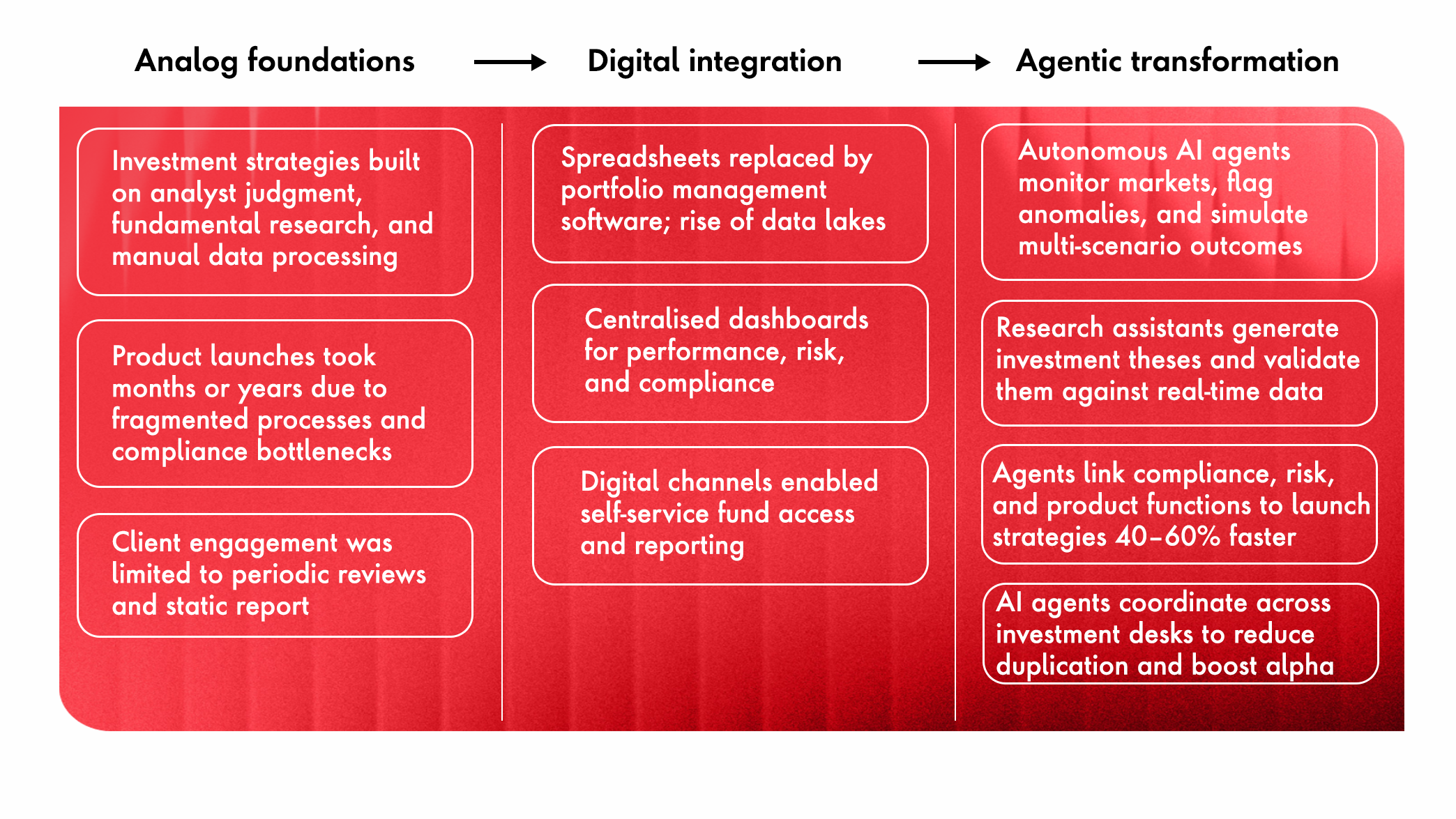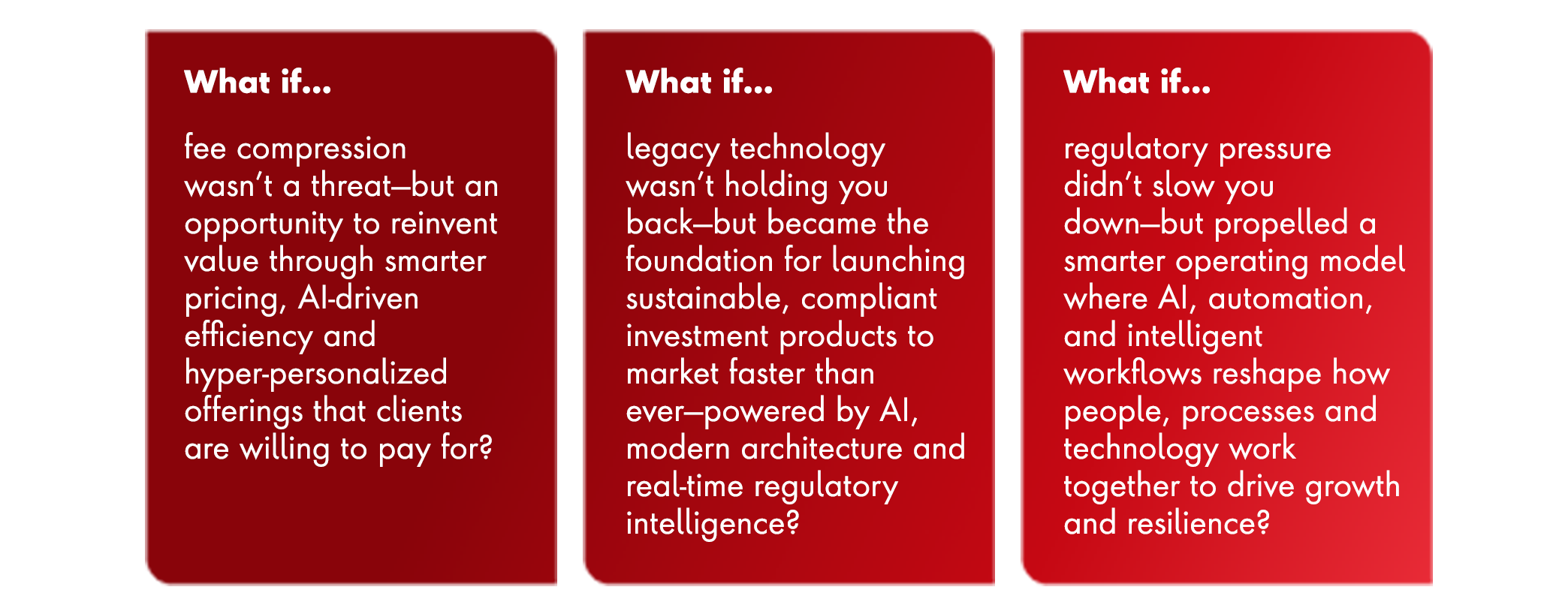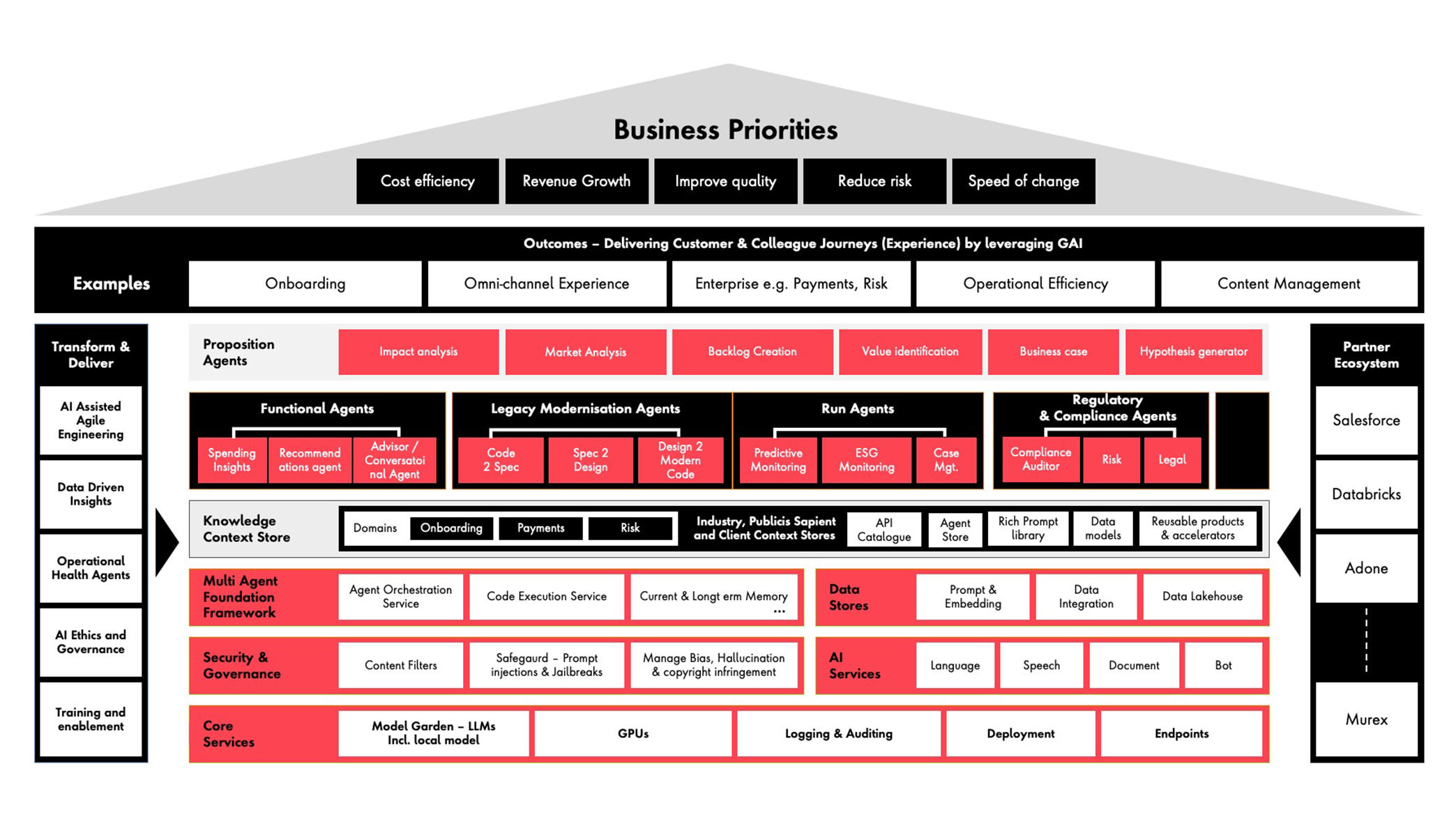What issue can we solve for you?
Type in your prompt above or try one of these suggestions
Suggested Prompt


Reinventing Value in Wealth & Asset Management with Generative AI
How agentic AI turns operational pressure into a catalyst for digital transformation.


- The asset and wealth management industry faces tightening margins, rising client expectations and escalating regulatory complexities that render traditional, siloed operations obsolete.
- Rising technological fragmentation and legacy systems are impeding timely decision-making and operational agility, thus demanding modern, integrated data architectures.
- Generative AI and automation are transforming the business model by shifting decision-making from manual, relationship-driven processes to intelligent, agent-based strategies.
- Forward-looking firms are leveraging platforms like Sapient Slingshot to modernize legacy systems, reduce tech debt and accelerate new product delivery while ensuring compliance.
- This transformative approach not only drives operational efficiency and cost reduction but also creates enhanced value through hyper-personalized client experiences and proactive market insights.
The asset and wealth management industry is at a critical inflection point.
Tightening margins, rising client expectations, and increasing regulatory complexity are placing unprecedented pressure on firms. The traditional playbook—built on manual processes, siloed business and technology functions, and relationship-driven models—is no longer sufficient.
For both asset and wealth managers, the challenge now goes beyond cutting costs or streamlining operations. It’s about fundamentally transforming how the business runs—from the front office to the back, from analog decision-making to intelligent, AI-enabled strategies. Clients today expect hyper-personalized service, faster response times, and proactive insights—all while firms grapple with compliance and scale.
This is where generative AI and automation are beginning to reshape the landscape. Far from just enhancing existing workflows, these technologies are enabling a smarter, more adaptive operating model—one that empowers professionals, accelerates innovation, and ultimately redefines how value is delivered.
Forward-looking firms aren’t waiting—they’re building the capabilities right now to lead in the next era of asset and wealth management.
Top challenges facing wealth and asset managers in 2025
Asset and wealth managers are under pressure from all sides, with compounding business challenges rooted in operational and technological complexity. Today’s leaders face five critical challenges:
1. Fee compression and margin pressure
Shrinking profitability from traditional products and platform bundling has led to tighter spreads and distribution pressures. Ever increasing costs from legacy infrastructure is adding to additional pressure, minimal use of automation in the middle and back office and limited self-service capabilities exacerbate the issue. Many firms lack the tools needed for cost transparency and profitability analysis—a growing concern under consumer duty mandates.
Solution: Leverage workflow automation, generative AI and shared services to drive efficiency, reduce the cost-to-serve and to enable faster time to market. Explore new products such as Privates or Multi Strategy to create a niche category for business.
2. Data and technology integration
Firms are struggling to make timely decisions and adhere to investment guidelines due to fragmented data landscapes. The influx of market, ESG and alternative data overwhelms legacy systems not designed for real-time or multi-source integration. Siloed data architectures across the front, middle and back office, combined with a lack of enterprise-wide governance and inconsistent data ownership, inhibit operational agility.
Solution: Adopt modern data architecture, leverage Gen AI accelerators to enable seamless front-to-back integration, implement robust governance and use AI/ML for intelligent enrichment and automation.
3. Regulatory and compliance pressure
Global regulatory shifts are forcing firms to transform their people, processes and technology. Yet, regulatory data often sits in disconnected systems, making reporting complex and time consuming. The lack of traceability, data lineage and on-demand report generation—especially with unstructured ESG data—increases non-compliance risk and reputational exposure.
Solution: Build traceable, auditable and real-time systems with integrated tagging and reporting capabilities, automated alerts leveraging generative AI alongside providing compliance with horizon scanning capabilities that shortens bloated compliance assessments. Plan ahead of time for AI governance models.
4. Legacy technology landscape
Outdated, monolithic systems with high costs of change are slowing innovation, time to market and increasing vendor risk. Point-to-point integrations limit scalability, and many platforms lack APIs or modular architecture needed for rapid development. Portfolio managers often lack the flexibility to adopt modern risk models, which further constrains agility.
Solution: Leverage Generative AI to accelerate the pace of legacy transformation.Adopt SaaS or cloud-native platforms with modular designs and scalable ecosystems as a foundational concept
5. Operating model inefficiencies
Manual processing, fragmented workflows and duplicated roles continue to drive high cost-to-serve and client dissatisfaction. The lack of automation tools and limited adoption of shared services or standardized operating models limits scalability and slows time-to-market for new products. Strategic programs tend to overrun leading to costs increase and business value erosion.
Solution: Accelerate SDLC transformation by embedding AI agents at critical points across the entire lifecycle (i.e. Analysis, Development, Testing, Deployment) , straight-through processing (STP) and intelligent automation, allowing the business units to collaborate more effectively. Streamline agile ways of working to deliver business value quicker.
Why agentic AI is the next inflection point in financial services
The convergence of these challenges is pushing executives to rethink traditional approaches. Many are embracing a new class of intelligent systems—AI agents that embed directly into operating models to drive scale, speed and precision.
These embedded agents mark a shift from digital integration to an agentic ignition point, unlocking capabilities that were previously impossible:
From analog to agentic

- Analog foundations: Investment strategies relied on analyst judgment, fundamental research and manual data processing; product launches took months or years due to fragmented workflows.
- Digital integration: Dashboards, data lakes and self-service tools improved visibility and reporting but did not fundamentally change how decisions were made.
- Agentic transformation: Autonomous AI agents now monitor markets, flag anomalies, simulate multi-scenario outcomes and accelerate new strategy and product launches by 40 to 60 percent.
Tangible business impact
- Cut down delivery time by 30 to 50 percent, significantly reducing time to market.
- Enhance transparency and reduce compliance risk with automated traceability.
- Reduce research and preparation time by 25 to 30 percent, improving alpha generation and client retention.
Agentic AI is not just about improving existing processes—it’s about reimagining how asset and wealth management firms think, operate and grow.
Asset and wealth management challenges as opportunities
What if…

How generative AI accelerators like Sapient Slingshot are driving financial transformation
Enter Sapient Slingshot, Publicis Sapient’s generative AI acceleration platform. Built for highly regulated industries, Slingshot helps organizations move from AI experimentation to enterprise-wide transformation—with speed, security and control.
Unlike generic LLM pilots or chatbot demos, Slingshot is purpose-built for financial services. It combines the power of generative AI with real enterprise infrastructure to solve for:
- Legacy modernization at scale
- AI-powered SDLC (software development lifecycle) acceleration
- Real-time decision-making through intelligent agents
- Data unification across business lines
- Personalized, auditable client experiences
The outcome? Reinvented value delivery across the full investment lifecycle—from onboarding and portfolio construction to compliance reporting and advisor enablement.
The business will receive value from the transformation, which includes:
- Reduced tech debt and infrastructure complexity
- Speeds up delivery of new features, apps and digital services
- Drives alpha generation and cost efficiencies simultaneously
- Powers enterprise level analytics
- Enhances regulatory readiness
Inside the agentic AI blueprint: build smarter, scalable financial operations
The P.S. Agentic AI blueprint is a modular, enterprise-ready framework that brings structure, speed and intelligence to complex financial environments. Slingshot offers a powerful combination of tools, workflows and foundational infrastructure that enables AI agents to drive enterprise transformation at scale.

1. Prompt libraries
Crafted by subject matter experts with deep financial services knowledge, these libraries are built to generate product-ready enterprise solutions aligned to specific business needs. These libraries include hundreds of tested prompts representing best practices across use cases, ensuring that each AI interaction is grounded in industry context and optimized for real outcomes.
2. Context awareness
Slingshot integrates extensive industry and domain expertise using proprietary Publicis Sapient InnerSource accelerators and assets. This allows AI agents to draw from rich “context stores” that ensure responses are both relevant and compliant, enabling seamless collaboration between business and IT.
3. Agent store
Slingshot provides a ready-to-deploy portfolio of foundational AI agents tailored to financial services. This agent store includes an industry-specific portal designed to automate and enhance common business processes. Agents can be deployed within weeks—accelerating time-to-value.
4. AI agent framework foundation
Slingshot’s architecture is built for scale, offering guardrails, controls and flexibility. It supports both open and closed LLMs and integrates seamlessly with existing enterprise systems. This proven foundation ensures AI adoption is secure, scalable and aligned with regulatory needs.
5. Intelligent workflows
Pre-configured intelligent workflows orchestrate the right mix of agents, prompts and context stores to solve complex enterprise problems. These workflows are tailored to the most common financial services use cases, enabling automation, insight generation and operational agility from day one.
Real-world examples of generative AI success in wealth and asset management
One of the world’s largest asset and wealth management firms, with over 600 billion CAD in AUM, partnered with Publicis Sapient to unlock new value through a coordinated generative AI initiative.
Using Slingshot and its agentic AI framework, the firm was able to:
- Make models intelligent to assist with complex business problems, reducing the reliance on labor intensive custom analytics reports
- Unify data access across roles—portfolio managers, engineers, analysts and executives—through consistent, clean and governed data layers
- Streamline operational processes, accelerating decision-making cycles and reducing wasted effort through process orchestration
What once took days of cross-functional coordination could now be done in minutes—while ensuring compliance and traceability throughout.
Key questions C-suite leaders should ask about generative AI adoption
As with any transformation, success begins with the right questions:
- Are we set up to move from AI experimentation to scalable implementation?
- Do we have the data, architecture, governance and talent to adopt agentic AI responsibly?
- Which parts of our operating model could benefit from AI acceleration?
- How can we use AI to not only cut costs “Do more with same”— and drive alpha through quick product time-to-market and intelligently connecting disparate departments?
Start your generative AI journey in wealth and asset management
The rules of engagement in asset and wealth management are being rewritten.
Efficiency alone won’t fuel growth. Compliance is essential—but when treated as a box-ticking exercise, it can stall innovation. And data won’t create value unless it’s activated by intelligent systems that understand business context, client needs, and strategic goals.
Agentic AI is not just a lever for productivity. It’s a way to rewire decision-making, collapse silos and create new forms of value—faster than traditional transformation programs ever could.
For firms ready to move beyond proof of concept, Slingshot provides a blueprint for action.
Let’s rethink legacy constraints. Let’s reimagine client experiences.



